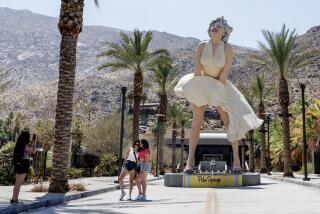Sanford removes Trayvon Martin memorial, outraging some activists
Less than a week after Trayvon Martinâs shooting death, community members built a memorial outside the gated neighborhood where he died, leaving laminated photos, silk flowers and other trinkets in the grass as a tribute to the slain teen.
Then it rained. The grass grew. Teddy bears rotted.
Residents started complaining, officials said, that the memorial defined their neighborhood. They called it an eyesore.
The city of Sanford let the memorial stand for more than four months. But Monday, Sanford employees boxed up the tribute and carted the items to the city museum. Now theyâre in storage, with a display date âto be determined,â City Manager Norton Bonaparte said. (Other city officials say the items are too ratty to be displayed.)
âIt had gotten incredibly shabby. It just looked horrible,â said Patty Mahany, a city commissioner whose district includes the subdivision where Martin died. âIt was no longer a fitting memorial.â
The move has prompted anger among black community leaders who say dismantling the tribute to Martin is the same as scrubbing the shooting from history.
Martin died Feb. 26 after being shot by neighborhood watch volunteer George Zimmerman. The fact that Zimmerman wasnât initially arrested resulted in protests across the nation, the later firing of the Sanford police chief and a Justice Department investigation.
Eventually, a special prosecutor was assigned to the case, and Zimmerman was charged with second-degree murder. He was released from jail Friday after posting bond for the second time. He has said he shot Martin in self-defense after Martin attacked him.
âItâs more of a psychological thing,â said Vera June, the legal advisor for the Concerned Citizens of Sanford, the group that first organized the curbside tribute. âWith the memorial gone, people will try to forget what happened.â
Thatâs partly the goal, Mahany said. The members of nearby gated communities and the parents of children at the elementary school across the street said theyâve looked long enough at a daily reminder of death.
âAt some point, youâve got to give it up and move forward,â Mahany said.
Concerned Citizens erected the memorial after the Martin family contacted them a few days after the shooting, said Francis Oliver, the curator of a black history museum in Sanford. The group kept the area maintained, making sure the memorial stayed on private land or in the right-of-way for traffic on bordering Oregon Avenue.
No one was informed that the memorial would be taken down, Oliver said.
But Bonaparte said in an email that the plans were indeed announced. A city staff member contacted Benjamin Crump, an attorney for the Martin family, to brief them on the plans to dismantle the memorial, Bonaparte said. The city offered to let the family keep any items.
âI think he is trying to make the right calls and do the right thing,â June said of Bonaparte. âSometimes you get things wrong.â
But no one seems to agree on what the right calls are.
Concerned Citizens met with Bonaparte to request that the items be put back, June said. The city will notify them by Monday. Concerned Citizens said it would like for the teddy bears, flowers and crosses to remain in place until the one-year anniversary of Martinâs death.
Failing that, she said, the tribute could go to the Goldsboro Museum in a historically black area of Sanford â a fitting location to remember an event that stirred a nationwide discussion on race.
âI told them no, because he did not die here,â Goldsboro curator Francine Oliver said, adding that she wants the items returned to their original location. âHe wasnât even from Sanford. Why would I put it in the Goldsboro? Why would I even put it in the Sanford Museum?â
The city chose the Sanford Museum because it is the only museum that it controls, Bonaparte said. The museum houses exhibits on the city and its founder, Henry Sanford, including his collection of artwork, books and manuscripts.
The most appropriate permanent memorial, June said, would be an educational exhibit on race and violence.
ALSO:
Florida teen loses arm -- but not his wit -- to alligator
Manâs 7th DUI involved collision, teen passengers -- and a judge
Former Penn State president says he was unaware of Sandusky abuse
Follow Laura on Twitter. Email: [email protected].
More to Read
Sign up for Essential California
The most important California stories and recommendations in your inbox every morning.
You may occasionally receive promotional content from the Los Angeles Times.











